30 Most Famous Buildings in Barcelona (Must-See Landmarks)
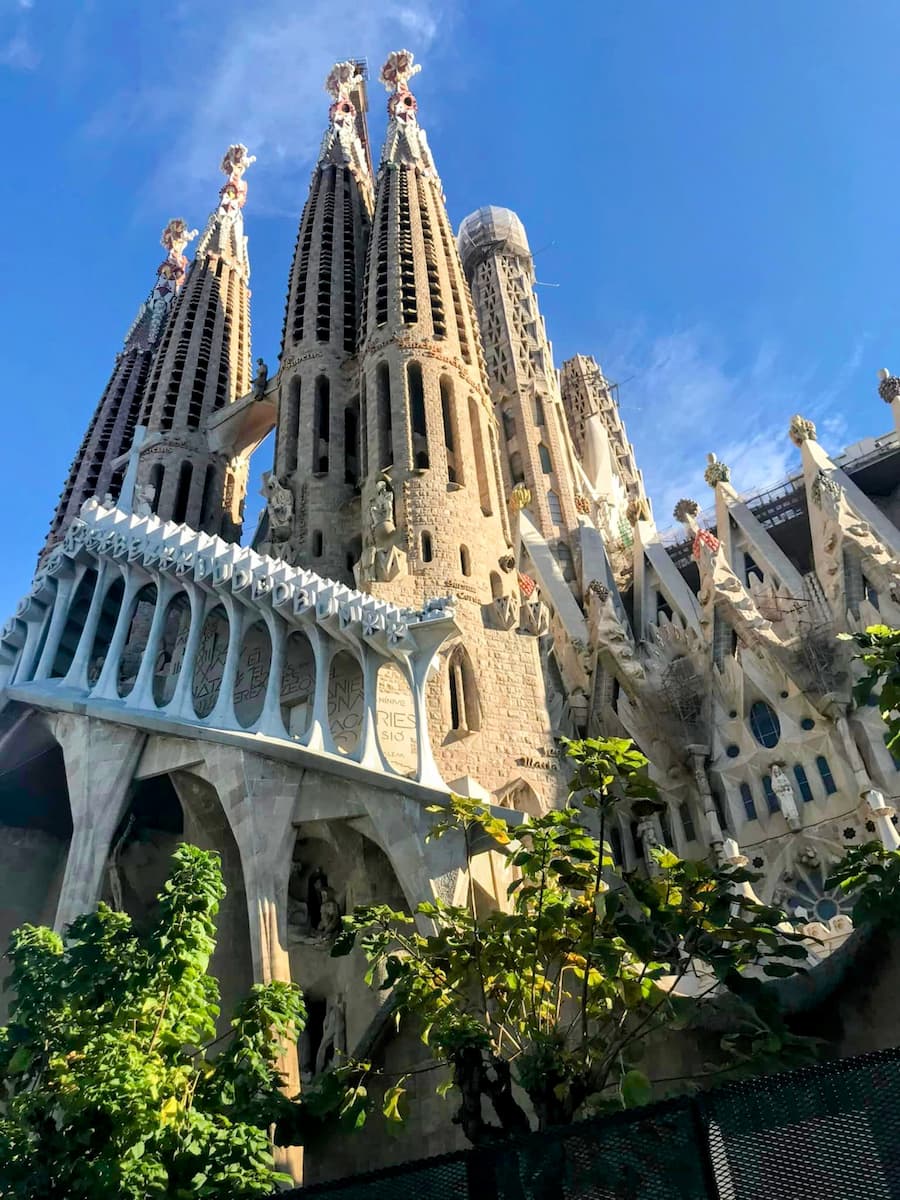
Barcelona is like an open-air museum, filled with buildings that are famous not just for their design, but for the stories they tell. You’ve got everything from Gaudí’s otherworldly creations to the grand gothic cathedrals and sleek modernist buildings.
I live in Spain and have been lucky enough to spend a lot of time in Barcelona, and every time I’m there, I’m struck by these incredible buildings everywhere you look.
So, what are these famous buildings in Barcelona, and why do they stand out? As you’ll see, while there are the big names like the Sagrada Familia, there are also some hidden gems that are just as fascinating.
Planning a trip to Barcelona last minute?
If you’re booking your trip to Barcelona last minute, I’ve got you covered. Below are some of the top tours, hotels, and more!
⭐ Most popular sights in Barcelona
- Sagrada Familia – tickets often sell out weeks in advance so get your entry ticket here (or entry tickets AND a guided tour here)
- Park Güell – grab your skip-the-line entry
- Casa Batlló – click here for tickets and audio guide
🌍 Top tours in Barcelona
- Montserrat Tour, Monastery and Winery (great day trip!)
- Flamenco Show at Tablao Flamenco Cordobes (incredible night out)
- Tapas Walking Tour with Food, Wine, and History (all the highlights at once)
🛏️ Top hotels in Barcelona
- Ohla Barcelona (5-star luxury with an amazing rooftop pool)
- Seventy Barcelona (boutique hotel with beautiful décor)
- Àmfores Boutique Guest House (great budget option with superb location)
🚌 Want free public transport while you’re in Barcelona? Check out the Hola Barcelona travel card!
Most famous buildings in Barcelona
1. Sagrada Família
First up is the iconic Sagrada Família. This monumental church is the masterpiece of Antoni Gaudí, Barcelona’s most famous architect whose work is synonymous with the city’s name. Construction started in 1882 and guess what? It’s still not finished!
That’s right, this building is a work in progress, but don’t let that stop you from visiting.

The Sagrada Família is a fusion of Gothic and Art Nouveau styles. The exterior looks like it’s straight out of a fairytale, with towering spires and intricate sculptures.
Inside, you’ll be amazed by the colorful stained glass and the tree-like columns that create a forest-like feel inside what is easily the most famous church in Barcelona (well, strictly speaking, it’s a basilica).
Here’s a tip: Make sure to visit the towers. The view of the city from up there is something else. Also, it’s worth getting a guided tour to really understand the symbolism and history behind this unique church.
PRO TIP: The Sagrada Familia is easily the most visited tourist site in Barcelona and tickets frequently sell out weeks ahead of time.
To make sure you don’t miss out, you need to book your tickets for the Sagrada Familia well in advance of your visit. As once they’re gone, they’re gone – and seeing inside is a definite must while you’re here.
2. Casa Milà (La Pedrera)
Next, let’s head to Casa Milà, commonly known as La Pedrera. This building, also designed by Gaudí, was quite controversial when it was built between 1906 and 1912.
Its undulating stone facade and twisting wrought iron balconies were unlike anything people had seen before.
In fact, Casa Milà stands out amongst Barcelona’s most famous architecture because it doesn’t have a single straight line. The roof is particularly fascinating with its chimneys that look like warriors.

The interior is just as impressive, with an attic that resembles a whale’s skeleton and an apartment that shows you what life was like in the early 20th century.
If you’re around in the evening, check out the light show on the roof. It’s a cool way to see this masterpiece in a different light – literally!
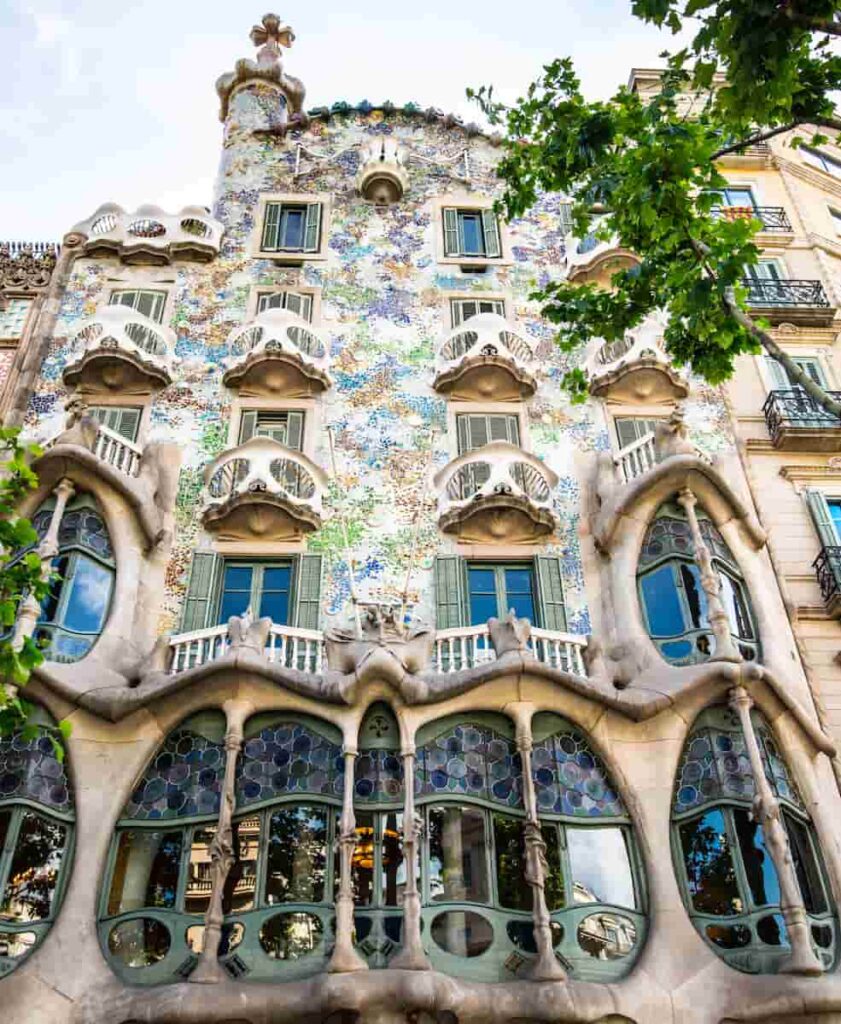
Modernism and Gaudí Walking Tour
The best tour for seeing Barcelona’s most impressive Modernist architecture in the one day.
With 10 different Modernist highlights, including the Sagrada Familia, Casa Batlló, Casa Amatller and more, you’ll learn all of the insights behind each of these masterpieces.
3. Casa Batlló
Casa Batlló is another one of Gaudí’s creations, and it’s easy to see his trademark style in the building’s colorful, wavy exterior. Inspired by nature, the facade is decorated with a mosaic made of broken ceramic tiles that shimmer in the sunlight.
This building is also known as the “House of Bones”, and you’ll understand why once you see its skeletal balconies and organic shapes.
Inside, the attention to detail is astounding. The blue-tiled light well, the curvy wooden doors, and the fireplace shaped like a mushroom are just some of the highlights.
One of my favorite parts of Casa Batlló is the roof, which is designed to look like the back of a dragon. Just FYI, it’s an excellent spot for photos!
4. Palau de la Música Catalana
If you’re a fan of music or just love seeing beautiful interiors, you can’t miss the Palau de la Música Catalana. This concert hall, built between 1905 and 1908 by architect Lluís Domènech i Montaner, is a celebration of Catalan art nouveau.
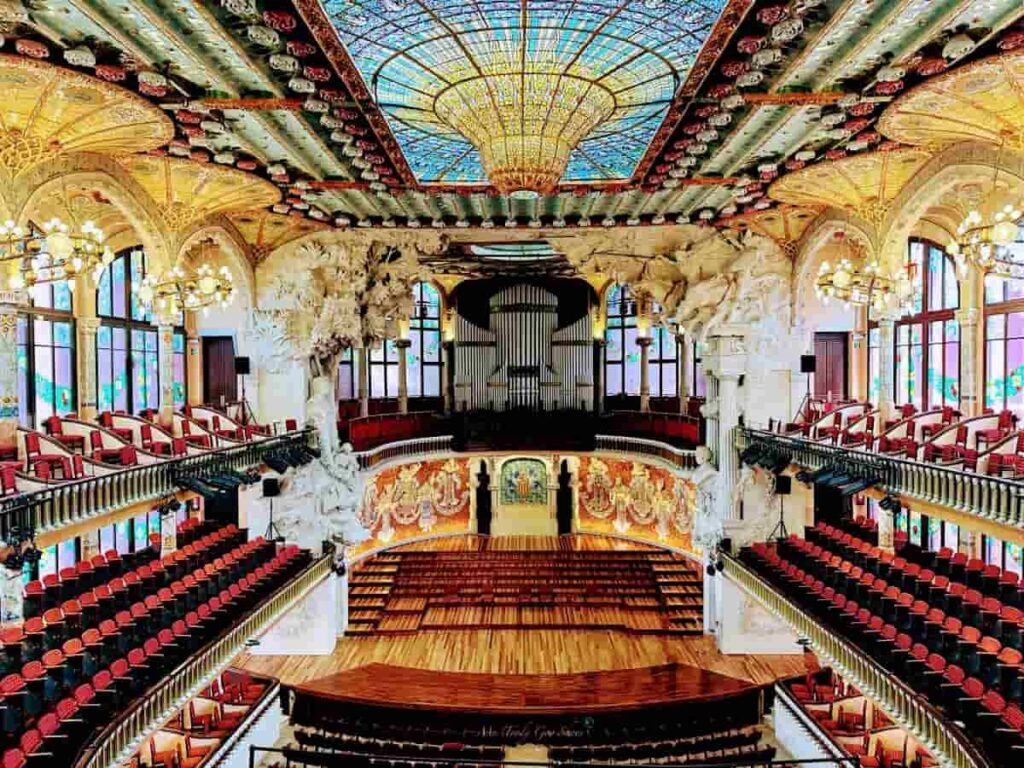
Its exterior is impressive, but the interior is where the magic really happens. The concert hall is a riot of color, with a stained glass skylight that’s simply awe-inspiring.
The stage is framed by sculptures that seem to come to life, and the whole place feels like you’ve stepped into a kaleidoscope. They offer guided tours, and I highly recommend attending a concert here if you can – it’s an experience like no other.
5. Barcelona Cathedral (Cathedral of the Holy Cross and Saint Eulalia)
Moving on, let’s talk about the Barcelona Cathedral, full name: Cathedral of the Holy Cross and Saint Eulalia. This Gothic masterpiece, located in the heart of the Gothic Quarter, dates back to the 13th century, though its façade was added in the 19th century.
The cathedral is dedicated to Eulalia of Barcelona, a co-patron saint of the city, and her story is as fascinating as the cathedral itself. Make sure to visit the cloister where 13 white geese are kept – they represent the age of Eulalia when she was martyred.
The interior is vast and serene, with soaring columns and beautiful chapels. And don’t miss the rooftop for a panoramic view of the city’s Gothic Quarter – it’s a bit of a climb, but totally worth it!
6. Park Güell
When you’re in Barcelona, you have to swing by Park Güell, yet another one of Gaudí’s creations. This public park, located on Carmel Hill, was originally part of a failed housing development.
Today, it’s one of Barcelona’s most beloved green spaces. In fact, the park is like a playground for the imagination, with whimsical structures, colorful mosaics, and fantastical designs.
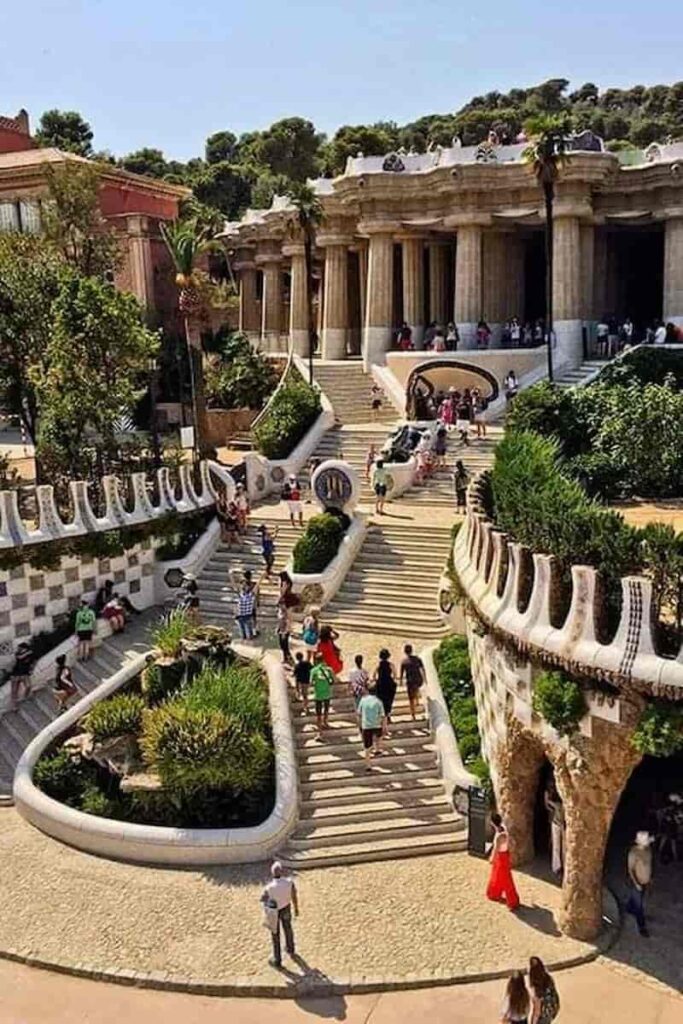
And the main terrace, with its serpentine bench covered in mosaic tiles, offers a great view of the city and is a popular spot for a quick rest.
Don’t forget to check out the Gaudí House Museum located within the park. It’s where the architect lived for a time, and it gives great insights into his life and work.
FYI: If you’re looking to visit both the Sagrada Familia and Park Güell and you’re short on time, you can get skip-the-line entry and a tour of both sights in one day right here.
7. Torre Glòries (formerly Torre Agbar)
Torre Glòries, previously known as Torre Agbar, is a skyscraper, which looks like it’s sprung right out of a sci-fi movie. It was designed by French architect Jean Nouvel and opened in 2005.
This building stands out in the Barcelona skyline with its unique shape – some say it resembles a geyser shooting up into the sky, while others think it looks a bit like… well, let’s just say it’s quite distinctively “adult” for some!
The building’s exterior is covered in glass and is lit up with more than 4,500 LED devices at night. The light shows are pretty impressive – they can create over 16 million colors!
While you can’t usually go inside (it’s an office building), just seeing it from the outside, especially at night, is quite a sight.
8. Camp Nou
If you’re a football fan, you can’t miss Camp Nou, the home stadium of FC Barcelona. Even if you’re not big on sports, this place is still worth a visit for its sheer size and energy.
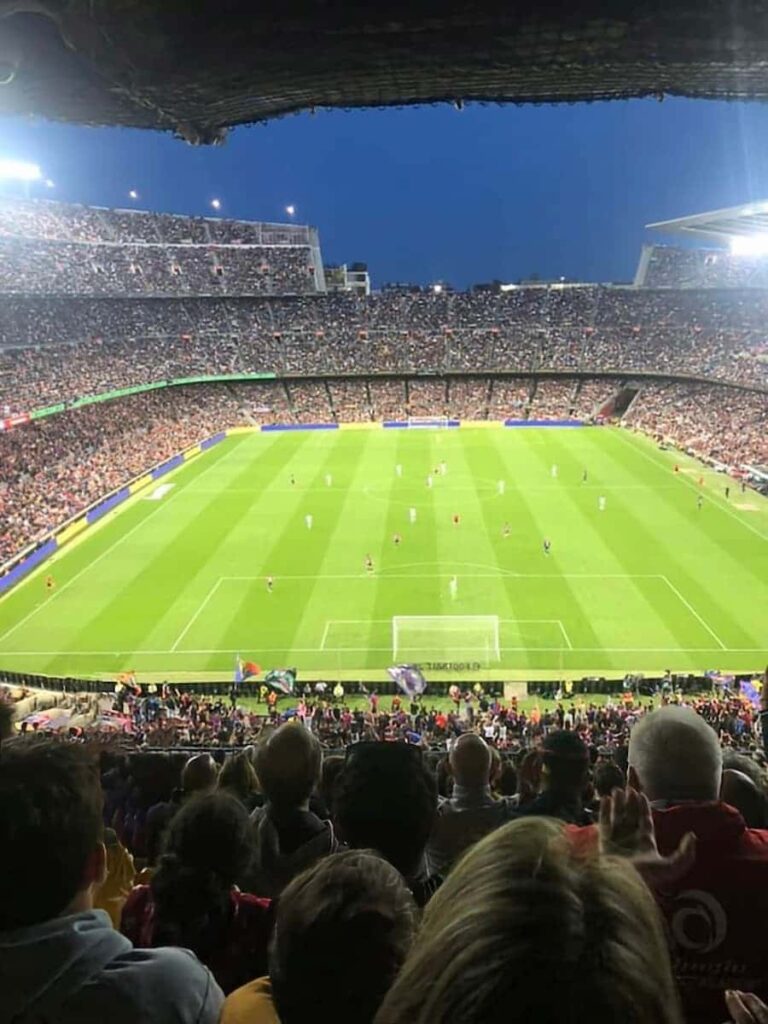
It’s the largest stadium in Europe, with a seating capacity of nearly 100,000! You can take a tour of the stadium and the museum, which is a real treat.
You’ll get to see the locker rooms, the tunnel leading to the pitch, and even sit on the team bench. If you’re lucky enough to catch a game, the atmosphere is electric – there’s nothing quite like it!
Plus, the FC Barcelona Museum is a journey through the club’s history, with trophies, memorabilia, and interactive displays. It’s actually the most visited museum in the city – yep, even despite all the Picassos and modern art you’ll find elsewhere in Barcelona, this one gets the most visitors. And all that popularity is for good reason, as you should come and see for yourself!

What’s your perfect destination for your dream trip to Spain?
Want to discover a city or live your island dreams?
Embrace the food scene or step through the pages of history?
Whatever your travel style, discover the perfect Spanish city to add to your trip here!
9. Hospital de Sant Pau
Hospital de Sant Pau isn’t your typical hospital – it’s a stunning example of Catalan Modernisme architecture, designed by Lluís Domènech i Montaner. The hospital was actually operational from 1930 to 2009 and is now a UNESCO World Heritage Site.
The complex is made up of several pavilions, each one more beautiful than the last, with colorful tiles, intricate sculptures, and lush gardens. It’s like stepping into a work of art.
The best part? It’s been transformed into a cultural center and museum, so you can explore the buildings and learn about their history and restoration.
10. Museu Picasso
If you’re a fan of art, or even just a little curious, the Museu Picasso in Barcelona is a spot you can’t miss. Located in the charming Born district, this museum showcases an extensive collection of works by Pablo Picasso, focusing mainly on his early years.
It’s housed in five beautiful medieval palaces, and the setting is as impressive as the art itself. But what’s really fascinating here is the Las Meninas series, where Picasso reinterprets Velázquez’s famous painting in his unique style.
Walking through the museum, you’ll get a real sense of Picasso’s journey as an artist and his deep connection to Barcelona. It’s not just about seeing his paintings – it’s about stepping into a part of his life.
11. Casa Vicens
Casa Vicens is where the incredible journey of Antoni Gaudí began. This is his first major project in Barcelona, completed in 1885, and it’s a real eye-catcher.
The building was originally designed as a summer house for the Vicens family and it’s a vivid showcase of Gaudí’s love for nature and Oriental influences. The exterior is adorned with colorful tiles and intricate brickwork, making it stand out in the Gràcia neighborhood.
Inside, you’ll find a blend of Moorish, neoclassical, and modernista styles. It’s like walking into a different era. Casa Vicens opened to the public as a museum in 2017, so you can explore its interior and the lovely garden.
It’s a bit off the beaten path compared to Gaudí’s other works, but absolutely worth the visit.
12. La Boqueria Market
Next up is La Boqueria Market, a feast for the senses located right off Las Ramblas. While it’s not a ‘building’ in the traditional sense, its iconic iron entrance and buzzing atmosphere make it an unmissable spot in Barcelona.
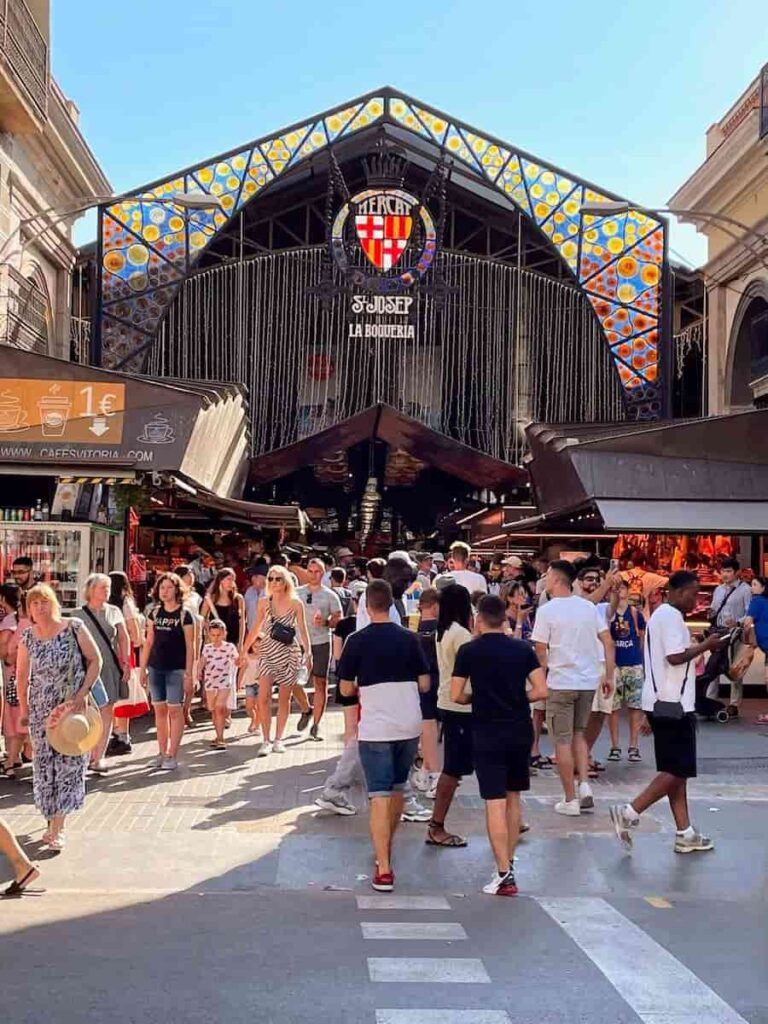
The market dates back to the 1200s, but the current structure was built in 1853. Inside, you’ll find an array of stalls selling everything from fresh fruits and veggies to mouth-watering tapas and sweets.
The colors, the smells, and the sounds create an atmosphere that’s both lively and authentically Catalan. Don’t forget to grab a fresh juice or a small bite from one of the many vendors – it’s a great way to refuel as you explore!
One of my top recommendations for things to do in Barcelona is this paella cooking experience.
You’ll start by being shown around La Boqueria market with an expert chef, who’ll explain how to pick out the best ingredients.
From there, you’ll be taken to the main event – a workshop on how to make your very own paella, tapas and sangria – before getting to eat and drink all your hard work. It’s a great way to experience the culinary side of Barcelona!
13. Palau Güell
For another one of Gaudí’s lesser-known but equally fascinating works, Palau Güell is where it’s at. This mansion was built for the Güell family between 1886 and 1890 and is located just off the lower end of Las Ramblas.
Palau Güell reflects Gaudí’s innovative approach to space and light. The central room was used for high society events and features a stunning parabolic dome.
Look out for the whimsical chimneys on the rooftop – they’re like sculptures in their own right. The building is dark and brooding compared to Gaudí’s later works, but it’s a testament to his early architectural genius.
14. Basilica of Santa Maria del Mar
The Basilica of Santa Maria del Mar is a hidden gem in the Born district. Built between 1329 and 1383 during Barcelona’s maritime and mercantile heyday, this church is an outstanding example of Catalan Gothic architecture.
What’s really cool about it is how it was built by the people, for the people – a true community project.

The interior is incredibly spacious and filled with natural light, creating a sense of peace and tranquility that’s hard to find in the busy city streets. The stained glass windows are especially beautiful in the late afternoon when the light shines through them.
There’s a simplicity and elegance to this church that sets it apart from others in the city.
15. Casa Amatller
Right next door to the more famous Casa Batlló is Casa Amatller, part of the famous Illa de la Discòrdia in the Eixample district. Designed by Josep Puig i Cadafalch, this building is a stunning mix of Gothic and Modernisme styles.
It was built for the chocolatier Antoni Amatller and completed in 1900. The facade of Casa Amatller is adorned with intricate designs and sculptures, making it a real treat for the eyes.
Inside, you can explore rooms that have been restored to their original design, giving you a glimpse into early 20th-century life in Barcelona. Don’t miss the chance to try some of the Amatller chocolate while you’re there – it’s delicious!
16. Magic Fountain of Montjuïc
The Magic Fountain of Montjuïc may not be a building, but it’s an unmissable spectacle in Barcelona. Built in 1929 for the International Exhibition, this fountain is much more than a water feature.
It’s a display of color, light, motion, music, and water acrobatics – a true feast for the senses!

The best time to visit is in the evening when the fountain comes alive with its spectacular light show. The shows are seasonal, so be sure to check the schedule in advance.
It’s a popular spot, so you might want to get there early to grab a good viewing spot. Trust me, it’s worth it – the atmosphere here, with the music and the lights reflecting in the water, is truly magical.
17. Museu Nacional d’Art de Catalunya (MNAC)
The Museu Nacional d’Art de Catalunya, or MNAC, is one of those places that takes your breath away – both for its collection and its architecture. Housed in the Palau Nacional on Montjuïc Hill, just behind the Magic Fountain, the building was constructed for the 1929 International Exhibition.
It’s a grand structure, with a sweeping view over Barcelona. And inside, the MNAC is home to an incredible collection of Catalan art, spanning a thousand years from Romanesque to Modern.
The highlight? The Romanesque frescoes and the Modernisme section. Even if you’re not an art buff, the building itself, with its domes, columns, and grand stairways, is worth a visit.
Plus, the view from the steps in front of the museum is a popular photo spot, especially at sunset.
18. Casa Lleó Morera
Casa Lleó Morera, another gem on the Illa de la Discòrdia, is a masterpiece of Modernisme architecture. Designed by Lluís Domènech i Montaner, it was completed in 1905.
What makes this building stand out is its incredible attention to detail – from the ornate sculptures on the facade to the stunning stained glass and woodwork inside.

The house was a major renovation project for the Morera family, who wanted to modernize their home. Today, it’s a testament to the creativity and craftsmanship of the Modernisme movement.
While the building is primarily used for offices now, you can still admire its beauty from the street, or better yet, join a guided tour to explore its interior.
19. Arc de Triomf
Next up, the Arc de Triomf. This triumphal arch, built as the main access gate for the 1888 Barcelona World Fair, is a striking structure with a distinctly Catalan flair.
Unlike other famous arches which are typically associated with military victories, this one was built to welcome visitors to the fair and is adorned with symbols and inscriptions that pay tribute to agriculture and industry.
The red brickwork and the intricate stone carvings make it a standout feature in the city. It’s also a popular spot for locals and tourists alike to relax, take a stroll, or snap some great photos.
The area around the arch often hosts events and markets, so there’s always something going on.
20. Gran Teatre del Liceu
The Gran Teatre del Liceu opened in 1847, with this opera house being one of the most significant landmarks on La Rambla. It has survived two fires and an anarchist bombing, each time being rebuilt grander than before.
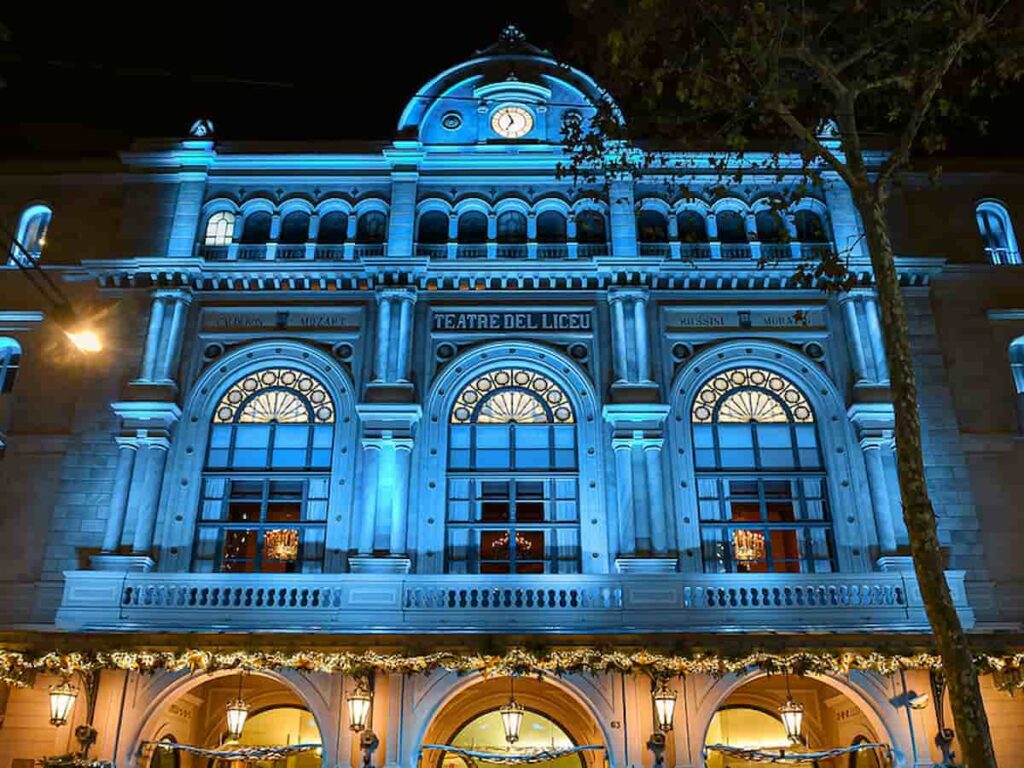
The Liceu is renowned for its rich and lavish interior, which includes a grand staircase, ornate ceilings, and a luxurious auditorium with a magnificent chandelier. If you’re interested in opera or just love beautiful interiors, catching a performance here is a must.
Alternatively, you can take a guided tour to learn about its history and see the opulence up close.
21. Casa de les Punxes
Casa de les Punxes, also known as Casa Terradas, is a building that looks like it came straight out of a fairytale. Designed by Josep Puig i Cadafalch, it was completed in 1905.
The building gets its name from the pointed spires that crown its roof, giving it a castle-like appearance.
What’s unique about Casa de les Punxes is its blend of medieval and modernista styles. The facade is adorned with intricate sculptures and ceramics, with themes revolving around Saint George (Sant Jordi), the patron saint of Catalonia.
It’s a private building, but there are guided tours available where you can learn about its history and architecture, and even step out onto one of its balconies.
22. Fundació Joan Miró
The Fundació Joan Miró is a museum dedicated to the work of the Catalan artist Joan Miró, with the building being a piece of art in itself. Designed by Josep Lluís Sert, a friend of Miró and a fellow Catalan, the building is a perfect example of modern architecture – it’s all clean lines, open spaces, and natural light.
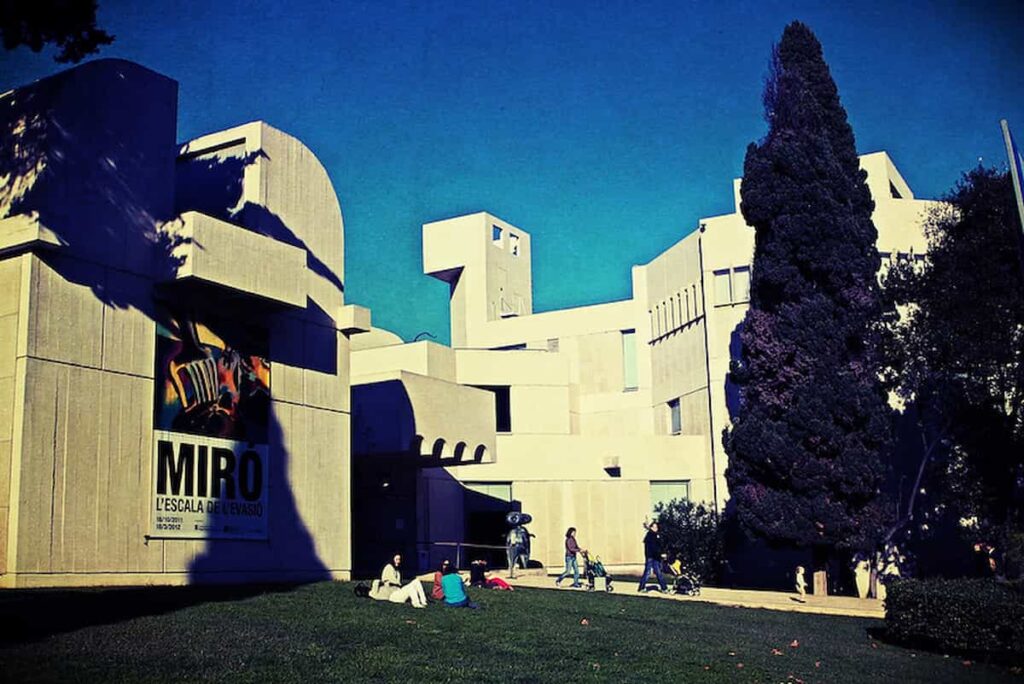
The museum houses the largest collection of Miró’s work, including his early sketches, paintings, sculptures, and textiles. The setting, on Montjuïc Hill, makes it a serene place to explore and appreciate art.
Don’t miss the sculpture garden, where you can enjoy Miró’s works in the open air, with a backdrop of beautiful views over Barcelona.
23. Santa Caterina Market
While everyone knows about La Boqueria, the Santa Caterina Market often gets overlooked, and it shouldn’t! The market was renovated in 2005 and now features a wavy, colorful roof that’s meant to mimic the look of a fruit and vegetable stand.
Inside, it’s a vibrant and lively market where locals shop for fresh produce, meats, and cheeses. There are also some great spots to grab a bite to eat.
What I love about this market is how it blends the old with the new – beneath the modern roof, you can still feel the pulse of a traditional Barcelona market. It’s also less crowded than La Boqueria, offering a more authentic experience.
24. Columbus Monument
The Columbus Monument is located at the lower end of La Rambla near the port. It was erected in 1888 in honor of Christopher Columbus’s first voyage to the Americas.
Standing at 60 meters tall, it’s quite the sight! You can actually take an elevator up to the viewing gallery near the top of the monument, which offers great views of La Rambla and the port – grab your tickets for this here.
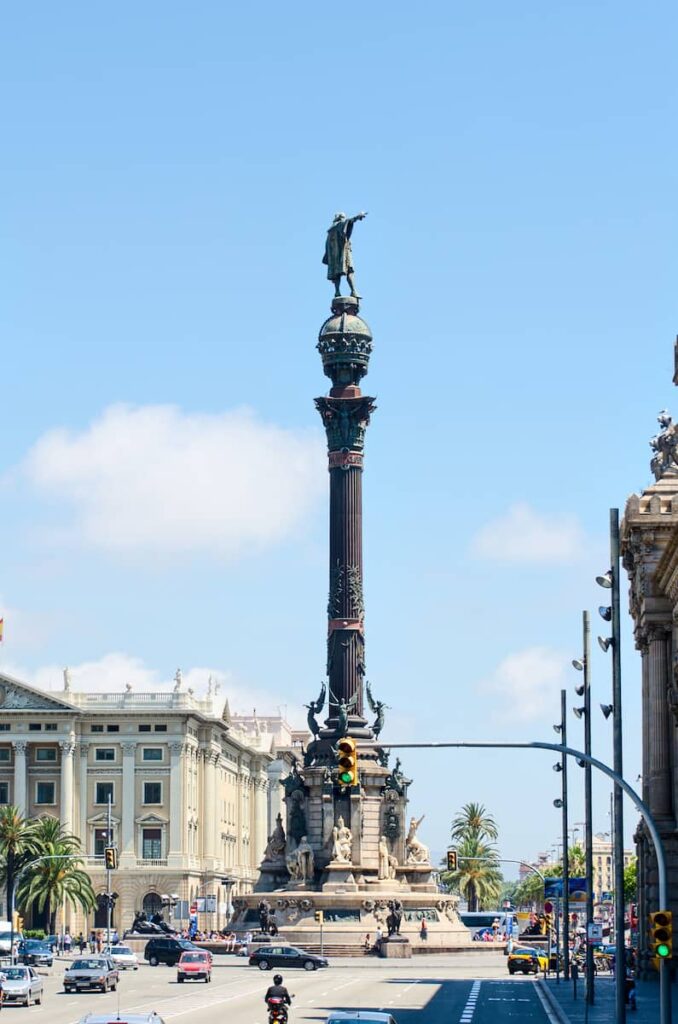
It’s a fun way to get a different perspective of the city. Plus, it’s always interesting to see a monument dedicated to such a controversial historical figure – it certainly sparks some thought and conversation.
25. Torre Bellesguard
Torre Bellesguard, also known as Casa Figueras, is one of Antoni Gaudí’s lesser-known works, but it’s definitely a hidden gem. Built between 1900 and 1909, this building is a fascinating blend of medieval and modernist styles.
Gaudí drew inspiration from the site’s history – it was once the location of a castle belonging to King Martin of Aragon.
The house has a castle-like appearance with its pointed towers and stone walls, but Gaudí’s signature style is evident in the colorful mosaics and whimsical shapes.
You can take a guided tour to learn all about its history and see some of the original furnishings. The views of Barcelona from here are pretty spectacular too!
26. Casa Calvet
Casa Calvet is often considered one of Gaudí’s more conservative works, but it’s full of subtle surprises. Built between 1898 and 1900, it was designed for a textile manufacturer and combines elements of Baroque and Modernisme.
The facade, with its curved wrought iron balconies and stone carvings, is elegant and understated. But look closer, and you’ll start to see Gaudí’s creative touches – like the mushroom-shaped chimneys on the roof.

The building is still used for offices and private residences, but you can dine in the ground-floor restaurant, which retains much of its original decor. It’s a unique experience to have a meal in a Gaudí-designed space!
27. MACBA (Museu d’Art Contemporani de Barcelona)
The MACBA is Barcelona’s contemporary art museum, located in the Raval district. Designed by American architect Richard Meier and completed in 1995, the building is a modern contrast to the historic architecture of the area.
The museum’s stark white walls and clean lines are a canvas for the play of light and shadows. Inside, you’ll find a collection of artworks from the mid-20th century onwards, with a focus on Spanish and Catalan artists.
The space is not just about the art but also about how the art interacts with the architecture. Even if contemporary art isn’t your thing, the building itself is worth a visit, especially for architecture enthusiasts.
28. Fundació Antoni Tàpies
The Fundació Antoni Tàpies isn’t just a museum – it’s a piece of art in itself. Named after the Catalan painter and sculptor Antoni Tàpies, the foundation is housed in a building designed by the modernist architect Lluís Domènech i Montaner.
The building was originally constructed between 1880 and 1885 as a publishing house and was later refurbished to house the foundation. What makes it stand out is the striking sculpture on the roof, created by Tàpies himself, called ‘Cloud and Chair’.

The museum holds the largest collection of Tàpies’ work and also hosts temporary exhibitions of contemporary art. It’s a fantastic place to get acquainted with Tàpies’ abstract and experimental style and to see how art and architecture can come together to create something truly unique.
29. Santa Maria del Pi
Santa Maria del Pi is a beautiful Gothic church located in the Barri Gòtic. Built in the 14th century, it’s a great example of Catalan Gothic architecture, with its impressive bell tower and large stained-glass rose window.
One of the unique things about this church is its simplicity compared to other Gothic churches in Europe. The interior is spacious and not overly decorated, which gives it a very serene atmosphere.
You can also climb up the bell tower for a stunning view of the Gothic Quarter. It’s a bit of a climb, but the panoramic view is totally worth it.
30. CaixaForum Barcelona
CaixaForum Barcelona is an absolute haven for contemporary art lovers. It’s not your typical gallery – this place used to be a factory!
Designed by the Modernista architect Josep Puig i Cadafalch, it’s true that it was originally a textile factory, but today, it’s been transformed into a bustling cultural center that hosts art exhibitions, music performances, and film screenings.
One of the coolest things about CaixaForum is how it blends the old with the new. The original brickwork of the factory is still there, creating a striking contrast with the modern art inside.
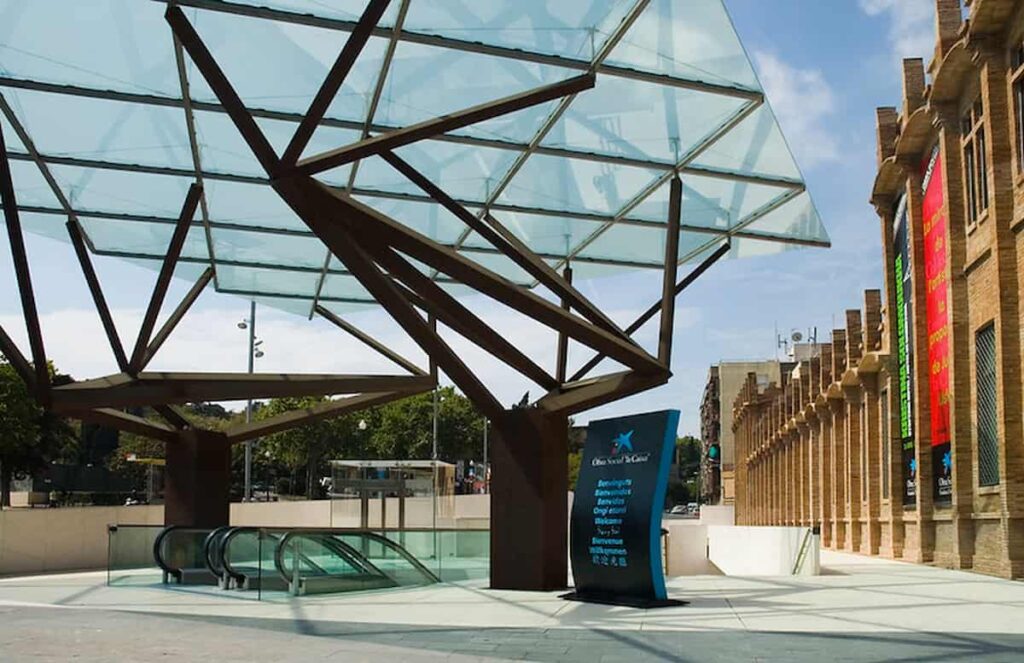
The exhibitions here are always changing, so there’s something new to see every time you visit. And hey, don’t miss the lush vertical garden outside – it’s like a piece of living art itself.
CaixaForum is a little off the beaten path, but it’s a gem worth exploring for its unique mix of industrial history and contemporary culture.
FAQs
What is the most famous architecture in Barcelona?
The most famous architecture in Barcelona is undoubtedly the Sagrada Família. This monumental church, designed by Antoni Gaudí, stands as an iconic symbol of the city and a masterpiece of Modernisme architecture. Its intricate facades, towering spires, and detailed interiors make it a must-visit for anyone in Barcelona.
Construction of the Sagrada Família began in 1882 and, amazingly, it’s still under construction – talk about a long-term project! Gaudí dedicated the latter part of his life to this building, and it embodies his unique style that blends Gothic and Art Nouveau forms.
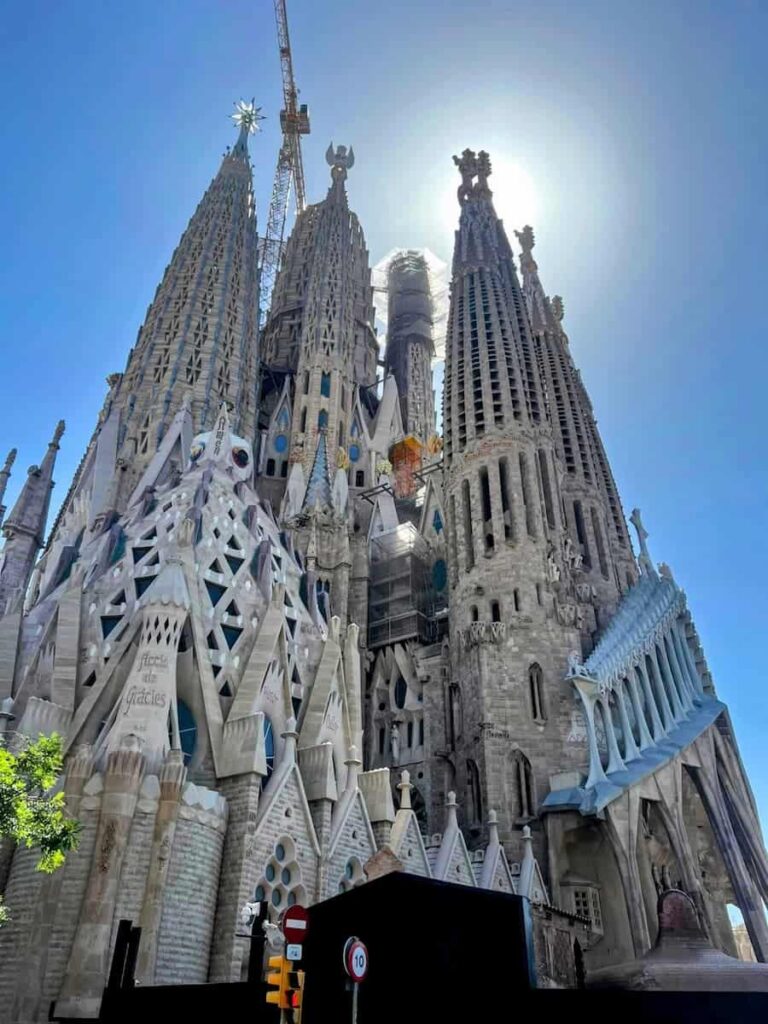
The interior is just as fascinating as the exterior, with columns designed to resemble trees and an array of colorful stained-glass windows. Visiting the Sagrada Família, you can’t help but be awed by the sheer creativity and detail that went into its design.
And don’t forget to check out the museum inside the church to learn about its history and the ongoing construction efforts.
PRO TIP: The Sagrada Familia is easily the most visited tourist site in Barcelona and tickets frequently sell out weeks ahead of time.
To make sure you don’t miss out, you need to book your tickets for the Sagrada Familia well in advance of your visit. As once they’re gone, they’re gone – and seeing inside is a definite must while you’re here.
What are the three famous landmarks in Barcelona?
Barcelona is chock-full of landmarks, but the three most famous are the Sagrada Família, Park Güell, and Casa Batlló. All three were designed by Antoni Gaudí and are prime examples of his distinctive architectural style. Each landmark offers a unique glimpse into Gaudí’s imaginative and groundbreaking approach to design.
Park Güell is a public park filled with gardens, architectonic elements, and amazing mosaic works. Originally intended as a housing development, it’s now a magical public space that offers stunning views of the city and the sea.
Casa Batlló, located in the heart of the city, is known for its vibrant colors, undulating façade, and dragon-back roof. Often referred to as the “House of Bones,” it’s a feast for the eyes with its unique blend of Modernisme and whimsical design.
These landmarks aren’t just buildings or parks; they’re artistic expressions that have become integral to the identity of Barcelona.
What is the most famous statue in Barcelona?
The most famous statue in Barcelona is the Columbus Monument, located at the lower end of La Rambla. This towering monument, which stands at 60 meters high, was erected in honor of Christopher Columbus and his first voyage to the Americas.
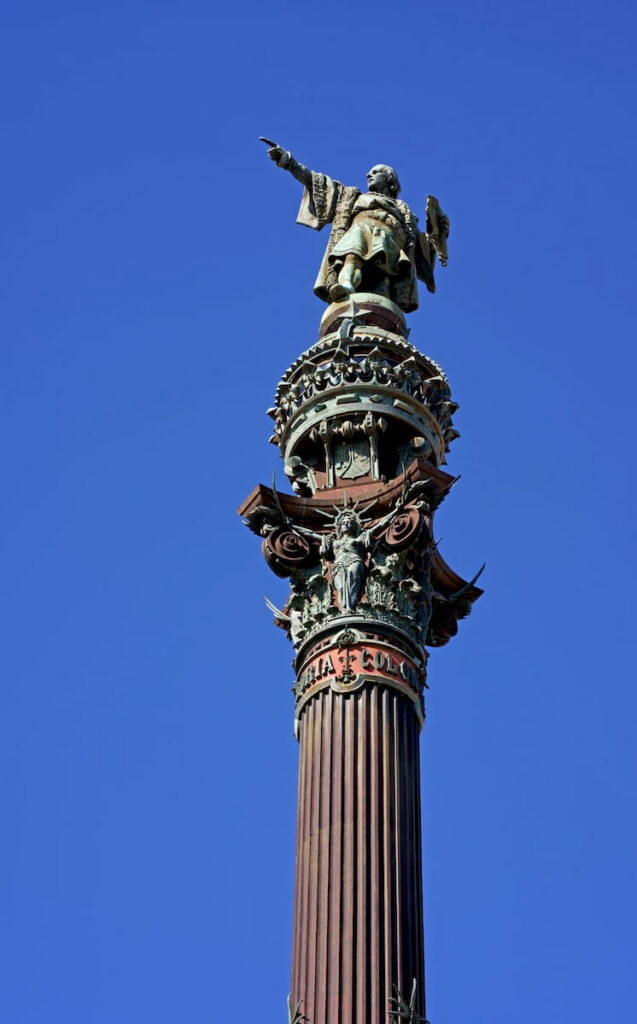
The statue of Columbus at the top points out towards the sea, supposedly towards the New World.
This monument, completed in 1888 for the Exposición Universal de Barcelona, isn’t only a tribute to Columbus but also a celebration of Barcelona’s maritime history. Visitors can take an elevator up to a viewing platform near the top (but you need to get tickets for this in advance), offering a unique vantage point over the city and the Mediterranean Sea.
The Columbus Monument is often bustling with tourists and locals alike, and it serves as a great starting point for exploring the city’s famous street, La Rambla. Surrounding the statue are sculptures and reliefs that depict scenes from Columbus’s life and explorations, adding layers of history and artistry to this iconic monument.
What is the famous colorful building in Barcelona?
The famous colorful building in Barcelona is Casa Batlló, a masterpiece of Modernisme architecture designed by Antoni Gaudí. This eye-catching building is known for its vibrant colors, whimsical shapes, and the striking, dragon-like roof. Its façade, adorned with a mosaic of colored glass and ceramic tiles, creates an iridescent effect that is simply mesmerizing.
Casa Batlló, part of the Illa de la Discòrdia in the Eixample district, was originally built in 1904. Gaudí remodeled the house in his distinctive style, adding new floors, a new facade, and reorganizing the interior space.
The building is a visual representation of the legend of Saint George (Sant Jordi), the patron saint of Catalonia, slaying the dragon. The roof represents the dragon’s back, and the balconies resemble the skulls and bones of the dragon’s victims.
Inside, the creativity continues with a stunning atrium, twisted staircase, and rooms with organic shapes. Casa Batlló isn’t just a building – it’s a piece of art that reflects Gaudí’s genius and his love for nature-inspired designs.
What famous building has never been finished in Barcelona and why?
The famous building in Barcelona that has never been finished is the Sagrada Família, designed by Antoni Gaudí. This colossal basilica began construction in 1882 and is still under construction today, making it one of the longest ongoing architectural projects in the world.
The complexity of Gaudí’s design, the intricacy of the details, and the interruptions due to various historical events are the main reasons behind its lengthy construction period.
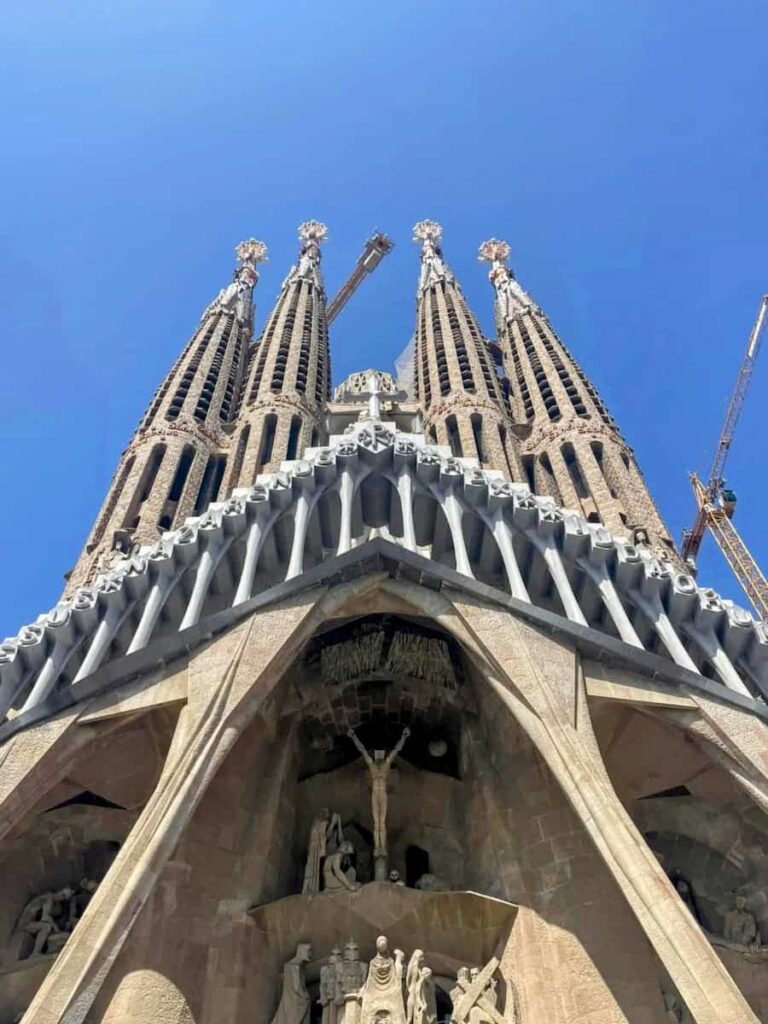
Gaudí spent over 40 years of his life dedicated to the project, and at the time of his death in 1926, less than a quarter of the construction was completed. The project’s slow progress was further hampered by the Spanish Civil War and the subsequent lack of funds and materials.
The intricate nature of Gaudí’s designs, which include vast amounts of detailed sculptures and the use of unique construction techniques, also contribute to the slow pace of work. Today, the construction relies on private donations and ticket sales from visitors.
Despite its unfinished state, the Sagrada Família is a UNESCO World Heritage Site and one of the most visited monuments in Spain. It is a symbol of Barcelona and a testament to Gaudí’s vision and the dedication of those who have worked on it over the decades.
What is the big cathedral in Barcelona called?
The big cathedral in Barcelona is called the Barcelona Cathedral, officially known as the Cathedral of the Holy Cross and Saint Eulalia. This impressive Gothic cathedral is located in the heart of the Gothic Quarter and is a significant symbol of the city’s religious and cultural history.
Dedicated to Eulalia of Barcelona, a co-patron saint of Barcelona, the cathedral stands as a magnificent example of medieval Gothic architecture.
Construction of the Barcelona Cathedral began in the 13th century and was completed in the 15th century, with some additional elements added in subsequent centuries. The cathedral is renowned for its stunning façade, soaring Gothic arches, and a beautifully serene cloister that houses 13 white geese, representing Saint Eulalia’s age when she was martyred.
Inside, the cathedral’s vast nave, exquisite stained glass windows, and numerous chapels each tell a story of Barcelona’s rich religious history. Visitors can also ascend to the rooftop for a panoramic view of the Gothic Quarter.
The cathedral hosts several important religious ceremonies throughout the year and remains a vital part of Barcelona’s cultural and spiritual life.
What is the big monument in Barcelona?
The big monument in Barcelona is the Columbus Monument, located at the end of La Rambla near the harbor. It’s a towering tribute to Christopher Columbus, standing at 60 meters high, and was erected to commemorate his first voyage to the Americas.
The statue at the top portrays Columbus pointing out towards the sea, symbolically towards the New World.

This striking monument, completed in 1888 for the Exposición Universal de Barcelona, is an important historical landmark and a popular tourist attraction. Visitors can take an elevator up to a viewing platform near the top, which offers breathtaking views of La Rambla, the city, and the Mediterranean Sea.
Around the base of the monument, there are detailed sculptures and reliefs that depict various scenes from Columbus’s life and his voyages. The Columbus Monument not only celebrates the famous explorer but also serves as a reminder of Barcelona’s maritime heritage and its role in world exploration.
Its location at the bustling intersection of La Rambla and the harbor makes it a perfect starting point for exploring the city’s many sights and sounds.
